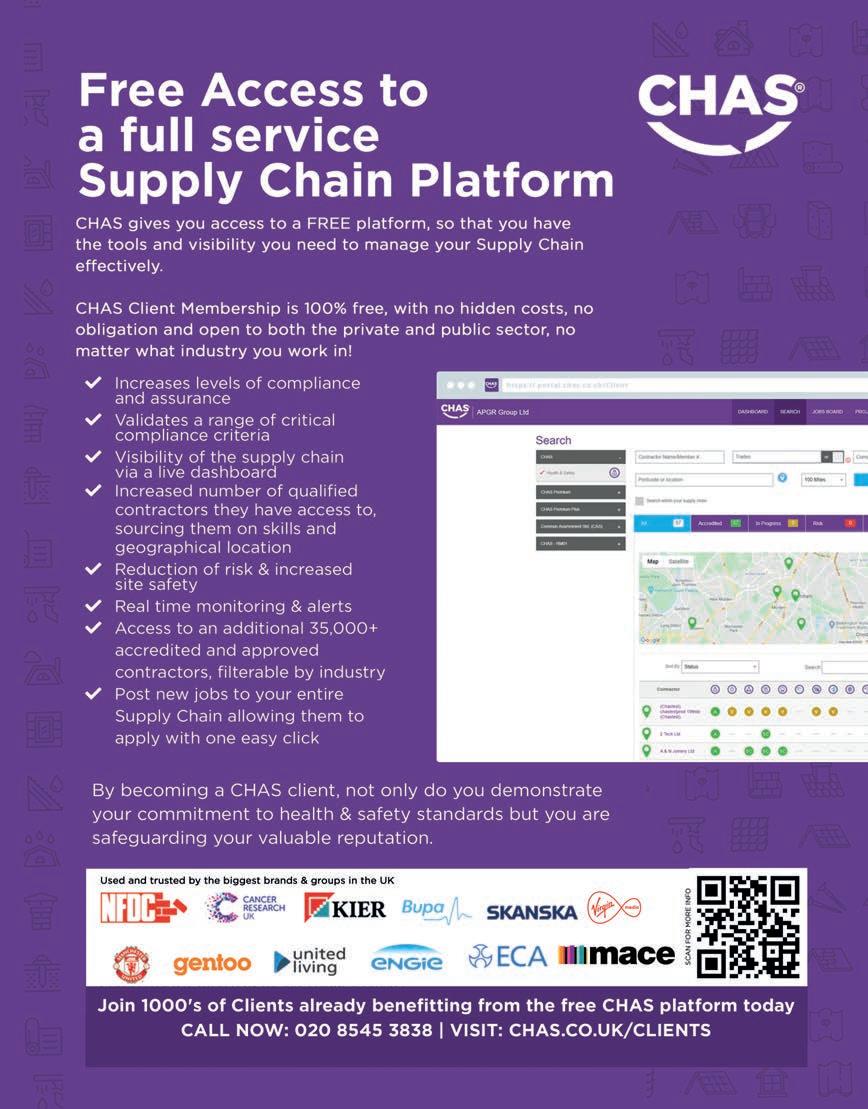
8 minute read
OSH AMBITIONS Master plan for Malaysia
3 0 MINS
MASTER PLAN FOR IOSH magazine spoke to Haji Omar bin Mat Piah, director general of the Department of Occupational Safety and Health in Malaysia, about how a commitment to improving OSH in an economy at full throttle is steered by the national administration. Malaysia
The evolution of health and safety laws and culture is usually a gradual process, going hand in hand with economic and social progress. But the fast pace of economic change in Malaysia – on track to achieve its Shared Prosperity Vision 2030 of increasing incomes – has required an acceleration in the development of its safety policies and practices.
Malaysia’s economic ambitions are matched by its OSH ambitions. The regulator, the Department of Occupational Safety and Health (DOSH), is clear that quality of life relies on quality of working life, and that prioritising people’s work wellbeing is a mainstay of productivity and economic success. As DOSH director general Haji Omar bin Mat Piah explains, this commitment to improving OSH is led from the very top.
‘Early last year, the prime minister launched our national policy for OSH,’ explains Omar. ‘To have the policy signed off by him was a big achievement in terms of promoting the preventive culture we want to inculcate.’ But with a legislative framework still in development, and with hard-to-reach small- and medium-sized enterprises (SMEs) accounting for more than 90% of businesses, there are real challenges in gaining the buy-in needed to ensure employers see investment in health and safety as an essential ingredient in their success.
Preventive culture DOSH is clear-sighted about its role in supporting Malaysia’s economic development, and in recent years it has set out its aims and expectations in ‘Master Plans’ – fi ve yearplans, each with a theme or focus, which detail OSH objectives and measurements of success. Previous Master Plans have concentrated on ownership and self-regulation. The current plan, which was launched in 2016 and concludes on 31 December this year, has sought to bring about a ‘preventive culture’. The plan contains three key objectives: to reduce the rate of work-related deaths by 10%, reduce the rate of occupational accidents by 10% and increase reporting of occupational diseases by 30%.
‘The results of the current Master Plan are yet to be fully evaluated,’ explains Omar, ‘but we monitor results against each objective and report to the minister at the end of every year, and we are making progress.’
Omar is aware that, however effective its activities, DOSH can’t drive change on
STATE OF THE NATION
POPULATION: 32.6 million WORKING-AGE POPULATION (15 TO 64 YEARS): 70% of population CAPITAL: Kuala Lumpur
ADMINISTRATION: federal constitutional monarchy made up of 13 states and three federal territories
ECONOMY: newly industrialised, with GDP growth among the highest in the region.
IOSH Mentoring Peer-to-peer learning for safety and health professionals.


We know that networking and collaborating with like-minded individuals to share knowledge and skills is invaluable. If you’re an IOSH Member, join IOSH Mentoring to enhance your career prospects and maintain your CPD.
its own: ‘We need support from workers, employers, employers’ associations, OSH practitioners and the government – there are many parties involved. If we want to bring about a preventive culture, where everyone actively participates and understands their right to a safe and healthy working environment, that goal needs to be respected at all levels, from the top management all the way through to individual workers.’
Design mentality The challenges DOSH has encountered in seeking the improvements in health and safety performance needed to support Malaysia’s economic ambitions will be familiar to OSH practitioners anywhere. ‘Standards in construction are alarming in comparison to the national average, with a fatality rate three times higher than the cross-industry average,’ Omar points out, ‘so the construction sector will be a focus for us.’ DOSH has introduced guidelines for construction, based on the UK’s Construction, Design and Management (CDM) Regulations, to clearly defi ne responsibilities to clients, contractors and designers – rather than just contractors, as per the current regulations.
‘The process of taking care of health and safety should begin at the design stage. That is very important, because after the design stage it’s much more diffi cult to make changes. But changing how we work requires a change of mindset, so we have to engage designers and developers.’
SME focus With SMEs making up the vast majority of businesses, reaching out to this section of employers has been a priority for DOSH. ‘We understand they have limited resources, and often have to work hard to stay in business,’ Omar acknowledges, ‘so we want them to be on board.’
Omar sees training as a key lever in engaging SMEs and persuading employers of the value of implementing an effective health and safety management system.
FAST FACTS

OSH in Malaysia
Work-related accident and fatality rates are on an established downward trend, while reporting of occupational disease is rising as awareness increases.
51,829 2005
The accident rate was 5.16 per 1000 workers in 2005; 3.68 in 2010; and 2.81 in 2015. In 2018, under the current Master Plan, the rate had fallen to 2.40
41,467 2010
38,753 2015
The total number of industrial accidents declined 25% between 2005 and 2015
14,186
DOSH received 1198 reports of occupational disease/poisoning in 2011, and 5960 reports in 2015. A total of 14,186 reports were made between 2011 and 2015, but DOSH believes these fi gures do not yet refl ect the true picture
In Malaysia, many SMEs – which make up 90% of businesses – fail to buy into health and safety
Last year, DOSH introduced a programme to encourage SMEs to employ a trained health and safety person: an OSH coordinator. The department developed a module for SMEs to help ensure the nominated person has the skills and knowledge to carry out their function.
‘Training is so important if businesses are to understand how to deal with risk and the principle of prevention; everyone needs to understand risk assessment and how risk controls work.
Health agenda There has been an effort in Malaysia to correct the imbalance between the attention given to safety and that given to health. Omar acknowledges that health risks often lack the immediacy of safety risks: ‘Many illnesses can take 10 to 15 years or more to develop, so it’s quite diffi cult for industry to prioritise health management.’ But he says that DOSH ‘can’t run away from the challenge’.
The under-reporting of occupational diseases and poisonings is an accepted problem in Malaysia, and there has been an effort under the current Master Plan to encourage employers – in consultation with occupational health practitioners – to report when they identify cases of occupational illness so that DOSH can investigate and take action as necessary. The target set out in 2016 was a challenging 30% increase in reporting, which seems within reach. But Omar is encouraged by signs that employers and employees are slowly gaining a better understanding of the risks they may encounter day to day.
Bright future Despite the variety of obstacles to overcome, Omar is optimistic about Malaysia’s ability to embed health and safety in work culture. The nation has embraced new technology and ways of working to support its progress to developed status, and Omar already sees evidence of how technology is supporting efforts to improve OSH performance
WORKING TOGETHER IOSH makes partnership progress in Malaysia
This year will see our partnership work in Malaysia move forward in positive ways.
IOSH has been working with the Malaysian government’s Department of Occupational Safety and Health, actively assisting in the process of enhancing OSH standards, including the development of the Occupational Safety and Health Master Plan 2025.
Last November, we established a new collaboration with the Malaysian Board of Technologists. And we are working closely with key OSH organisations, including the National Institute of Occupational Safety and Health, the Malaysian Society for Occupational Safety and Health, and the Malaysian Occupational Safety and Health Practitioners’ Association, to enhance OSH competencies.
Plans for 2020 include involvement in Malaysia’s hosting of the 35th Asia-Pacifi c Occupational Safety and Health Organisation (APOSHO) event in August. We will supply more detailed updates in future editions of IOSH magazine.

– from analysis of chemicals to online data management and analytics. ‘Technology is also helping with inspections,’ he notes. ‘For example, we can use drones when we are inspecting construction sites: they can zoom in and capture footage of areas that may be diffi cult or unsafe for people to access, so that we can detect any unsafe acts and conditions.’ Omar is keen to benchmark Malaysia’s progress against that of other countries: ‘We welcome professionals from overseas; we want to take advice. We also benefi t from help from international auditors, so that we know where we are and where there are gaps.
‘We will look to develop good cooperation with IOSH, to ensure our inspectors and other practitioners are competent. Positive collaboration with international associations will help us raise standards; it’s about mutual relationships. For example, the programme with the Japanese International Cooperation Agency, where we gain knowledge from each other.’
Priorities for the next Master Plan will be fi nalised between now and September, but one objective will be to encourage as many organisations as possible to migrate to – or work towards – ISO 45001. Omar sees the standard as aligning perfectly with DOSH’s overarching aims: to see OSH at the heart of every workplace and central to Malaysia’s strides towards becoming a high-productivity, developed economy.










